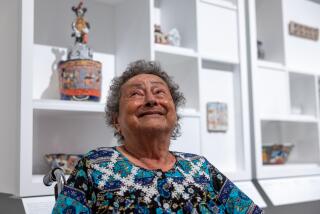Interpretations of America
Cuban culture is in:
* Bonnie Raitt, Jimmy Buffett, Joan Osborne and other stars performed in Havana last month in the biggest U.S.-Cuban musical exchange in 40 years.
* Cubanismo!, the Afro-Cuban band of some of the island’s finest musicians, performed in Irvine recently.
* The Philadelphia Boys Choir and Men’s Chorale and the Milwaukee Symphony are planning Cuban tours later this year.
Now the visual arts are taking center stage. The University of Arizona, San Francisco State University and two prominent Los Angeles galleries are among those showcasing Cuban artists this spring. Last week, UC Irvine’s Art Gallery opened a traveling exhibition of Cuban art billed as the first of its kind.
“1990s Art From Cuba: A National Residency and Exhibition Program” showcases work made by five artists during seven-week residencies each spent in arts centers around the U.S. two years ago.
The multimedia traveling exhibit, which has been to New York and Chicago, includes work that explores deeply personal concerns, Cuban or American social and political issues and art that reflects the artists’ startled reactions to America. “People felt like they learned a lot about Cuba,” co-organizer Betti-Sue Hurtz said.
The project took root in 1994 when Hurtz, then director of the Longwood Arts Project, part of New York’s Bronx Council on the Arts, flew to Cuba with Holly Block, executive director of New York’s Art in General, an alternative gallery.
Both women were fascinated by art made by Latinos and Cuba’s developing contemporary art community, which has kept up to speed on postmodern trends and has sponsored a biennial in Havana since 1984.
The women, who made a second trip to Cuba two years later, realized that few Cuban artists working in the early to mid-’90s had traveled to America. Many had exhibited here in the previous decade, Hurtz said, but because many also had defected, and remained in the U.S., visas had become harder to come by.
“So that history produced a kind of pressure when we were working on this,” Hurtz said during a recent phone interview from the Bronx Museum of the Arts, where she is now guest curator. Still, she said, Cuban cultural ministry officials were receptive to the project.
The officials, eager for good public relations, predicted that “when the U.S. gets to meet the artists [the curators wanted to invite] and hear what they have to say about Cuba, the mythology of how bad Cuba is will be dispelled,” Hurtz said.
The artists chosen have criticized the Cuban government. But they were very careful about what they said publicly, Hurtz said, and they never directly criticized Castro. “So you won’t see name-calling or finger-pointing of specific people.”
Viewers will, however, see Abel Barroso’s frank exploration of Cuba’s post-revolutionary economy and growing reliance on trade with foreign countries in “Rush for Freeland.” The installation, which Barroso created at San Diego’s Centro Cultural de la Raza, comprises wooden hobby horses, each representing “the countries outside of Cuba leaving with all of the [island’s] riches,” Barroso writes in a catalog for the show.
Tania Bruguera, meanwhile, staged a performance while at the Art Institute of Chicago in response to the homelessness she encountered on the city’s streets. It drew a parallel between these marginalized people and the rootlessness of Cuban exiles living there and is represented in the exhibit in Irvine by old clothes and other props, Hurtz said.
“Bruguera was totally blown away by the homeless community in Chicago,” she said, “because at the time you didn’t see homelessness in Cuba; even though there were poor people, everyone was somehow taken care of.”
Issues of perception transfixed artist Manuel Pina, who shot a series of large photographs while in residence at the Hallwalls Contemporary Arts Space in Buffalo, N.Y. One depicts a woman in a short skirt whom Cubans would assume to be a prostitute, Hurtz said. Americans would immediately identify the woman as a model in a clothing ad.
“A number of the artists involved in the project talked about how they couldn’t tell, while in Cuba, how their images would be read here,” Hurtz said. “They discussed lots of issues about the translation of imagery from one cultural context to another.”
Highly personal concerns are explored in Sandra Ceballos’ work, which includes blood-stained surgical garments, pills and bandages that the artist relates to the “dark parts of the human experience.” During her residency at Art in General, she also photographed herself while acting “crazy,” Hurtz said, as a form of protest against rigid Cuban social mores.
“Craziness and the internal life were very much suppressed during the Soviet period in Cuba. . . . People didn’t express out-of-sync emotions or mental instability.”
Lazaro Saavedra, who had a residency at DiverseWorks Art Space in Houston, writes very little about his haunting marionettes in the show’s catalog. “There is no specific cultural reference,” he writes. “They are just generic human being forms.”
But Saavedra bespeaks the dearth of art materials available to Cuban artists a few years ago. The artist carved the marionettes out of soft wood, “because you could always get wood and a knife,” said Hurtz, who hopes viewers gain a new perception through the exhibition, so that people don’t think only about politics when they think about Cuba.
“Maybe it will get people thinking about Cuba as a lively place which produces good artists, and maybe that will help bring about a more progressive solution to the conflict and hostilities between the two countries. I might be wrong, but that’s my hope.”
* “1990s Art From Cuba: A National Residency and Exhibition Program” runs through Saturday at the UC Irvine Art Gallery, Mesa and University drives. Free. Noon-5 p.m. Monday-Saturday. (949) 824-6610.
More to Read
The biggest entertainment stories
Get our big stories about Hollywood, film, television, music, arts, culture and more right in your inbox as soon as they publish.
You may occasionally receive promotional content from the Los Angeles Times.










